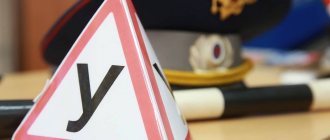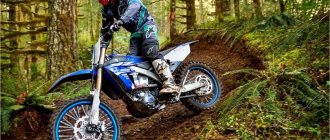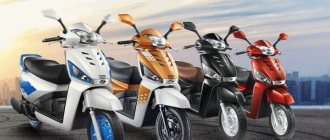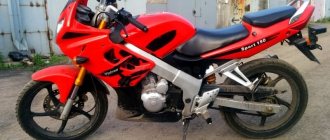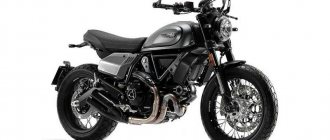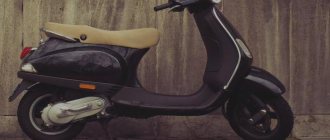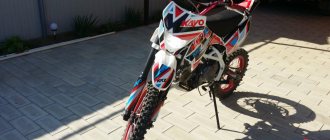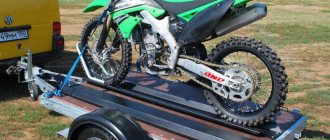Drivers of large vehicles are more responsible in learning and following traffic rules than owners of scooters and mopeds. This may be due to the size of these vehicles. Accordingly, the attitude towards traffic rules is less serious, which in turn creates no less tragic emergency situations.
Based on this, we intend to focus on the rules for drivers of scooters and mopeds. The timing is more than right - with the onset of warm weather, scooters are often seen on the roads.
I would like to draw attention to an important nuance - according to the rules, the concept of a scooter is included in the concept of a moped. Thus, traffic rules for scooters correspond to traffic rules for mopeds. Both of these vehicles are one and the same according to traffic rules. Let's analyze in detail the traffic rules for scooters in 2018-2022.
Where you can ride:
Moped drivers must move along the right edge of the roadway in a single file or in the lane for cyclists .
Moped drivers are allowed to move along the side of the road if this does not interfere with pedestrians.
“ Lane for cyclists ” is a lane of the roadway intended for the movement of cyclists and mopeds, separated from the rest of the roadway by horizontal markings and marked with sign 4.4.1 in combination with sign 8.14 located above the lane.
If the movement of a cyclist on a sidewalk, pedestrian path, shoulder or within pedestrian zones endangers or interferes with the movement of other persons, the cyclist must dismount and follow the requirements provided for by these Rules for the movement of pedestrians.
What are the rules for electric scooters?
Which road users are people on electric scooters considered to be: pedestrians, cyclists or moped drivers? What traffic rules apply to electric scooters? Do you need a helmet like on a moped or motorcycle? Is it possible to drive on the roadway rather than on the sidewalk?
The electric scooter is an example of how laws do not always keep up with technological progress. Previously, scooters looked so that even traffic rules modestly classified scooters as pedestrians. And then the situation changed.
Modern scooters go faster than the old Moskvich. But if a Moskvich needs a license, an electric scooter does not. Progress has outpaced legislation.
But that doesn't mean scooter drivers can do whatever they want. This depends on the power of the scooter's engine and its maximum speed.
Prohibited:
(Features for mopeds in addition to the general traffic rules):
- violate the prohibition signs
- move on the road without a fastened motorcycle helmet.
- move on pedestrian sidewalks
- roads marked with signs: 5.1 and 5.3
- drive on the road without low beam headlights on.
- turn left or turn around on roads with tram traffic and on roads that have more than one lane for traffic in a given direction. Moreover, it does not matter where the tram tracks are located (in the middle of the roadway or on the side behind the sidewalk). Turning and turning around is prohibited in any case. The scooter driver always has the opportunity to stop, dismount from the vehicle and roll the scooter across the crossing and become a driver again.)
- drive a moped without holding the handlebars with at least one hand;
- It is prohibited to tow mopeds, as well as tow with bicycles and mopeds, except for towing a trailer designed for use with a bicycle or moped.
- transport cargo that protrudes beyond the dimensions by more than 0.5 m in length or width, or cargo that interferes with control;
- transport passengers if this is not provided for by the design of the vehicle;
- transport children under 7 years of age in the absence of specially equipped places for them;
From the point of view of traffic rules, a scooter driver is a pedestrian
According to traffic regulations, the driver of a scooter is treated as a pedestrian. So are people on roller skates and those who use sleds, carts, strollers or wheelchairs.
A driver's license is not required to operate a scooter, and a helmet is also not needed: pedestrians do not wear them.
This entails the responsibilities of the scooter driver:
For scooters that are driven solely by the human foot, such requirements seem quite reasonable.
But the law does not always keep up with progress. An electric motor was attached to the scooter, and its speed characteristics changed. But the traffic rules requirements remain the same.
Stop and Parking
Stopping and parking of vehicles is permitted on the right side of the road on the side of the road, and in its absence - on the roadway at its edge and in the cases established by paragraph 12.2 of the Rules - on the sidewalk.
12.2. It is allowed to park a vehicle in one row parallel to the edge of the roadway, with the exception of those places where the configuration (local widening of the roadway) allows for a different arrangement of vehicles. Two-wheeled vehicles without a side trailer may be parked in two rows.
Parking on the edge of the sidewalk bordering the roadway is permitted only for cars, motorcycles, mopeds and bicycles in places marked with sign 6.4 with one of the signs 8.4.7, 8.6.2, 8.6.3, 8.6.6 8.6.9.
What is possible and what is not?
For owners of vehicles of category M, there are some prohibitions, as well as mandatory conditions for driving on public roads.
What must a moped driver do?
Important! The passenger is not required to wear a helmet (see paragraph 24.8 of the Rules).
Remember! Remember to turn on the lights when driving during the day. This measure will allow other road users to see you in advance. Thus, you will avoid injuries, danger to health and life, and unnecessary material costs.
Prohibited to do
It is worth remembering that in addition to these responsibilities, the driver of a scooter or moped must also follow the traffic rules for cars, observe the order of passage of intersections and other points.
Interesting fact! There is a generally accepted opinion that traffic police officers are prohibited from chasing two-wheeled lawbreakers - this is a myth. Law enforcement officers can prosecute scooter riders and issue them fines. Often they simply abandon this idea, fearing for the health of the moped driver, who could cause an accident during the chase.
After receiving the work assignment, the Delivery Specialist must:
- check the technical condition of the vehicle, paying attention to the serviceability of tires, brakes, steering, wiring, headlights, brake lights, direction indicators, sound signal, instrumentation, rear-view mirrors;
- refuel the vehicle with fuel and other technical fluids only at gas stations and service points;
- check the operability and serviceability of the engine at idle, lighting and instrumentation, and also check the operation of the brakes and steering at low speed;
Correct placement on the road
The rules prescribe certain features for mopeds when driving in a lane and when crossing intersections.
Where can you ride a moped?
Here is a list of rules to follow if you are driving a moped:
How to make a left turn?
For scooter riders, there are certain restrictions when turning left:
If it is necessary to turn left and such a maneuver is prohibited, the scooter driver, according to the rules, must do the following. Get off the scooter and cross the intersection at the pedestrian crossing, while holding the scooter in your hands next to you.
Note! You cannot cross an intersection at a pedestrian crossing while sitting on a scooter!
How many people can you carry?
The rules also stipulate such an item as transporting passengers on a scooter or moped. Below is how to do it correctly:
The delivery specialist should not travel under the following circumstances:
- a malfunction of mechanisms and systems has been detected in which the operation of the vehicle is prohibited;
- discrepancy between the characteristics of the vehicle and the characteristics of the cargo in terms of volume, carrying capacity, length and other parameters;
- absence or malfunction of lighting fixtures, rear-view mirrors, signaling devices.
If violations or malfunctions are detected, the delivery specialist is obliged to inform the person responsible for the release of vehicles about the technical faulty condition of the vehicle, as well as the director of the restaurant.
Similar questions
I found myself in a situation: I forgot my documents, the IDPS stopped me, fined me 100 rubles and threatened to detain my car, but let me go. The TABLE OF PENALTIES of the traffic police actually provides for a violation of clause 2.1.1 of the traffic rules a warning or a fine of 100 rubles + removal from control and detention of the vehicle, and in article of the Code of Administrative Offenses 12.3 part 1 under which I was fined by the traffic police, a warning or a fine is provided, and there is no mention of any detention it says.
[Article 12.3. Driving a vehicle by a driver who does not have the documents provided for by the Traffic Rules
Question: Could the inspector actually remove me from management and what document in this case would be used to guide the TABLE OF PENALTIES or the Code of Administrative Offenses? Thank you.
Source
Features of moped control
It is prohibited to start driving without using personal protective equipment.
Motorcyclist landing.
When boarding a moped, the main point of support is the motorcyclist's legs, namely the inner thigh, which rests on the surface of the saddle, gas tank and foot. When driving a moped, the motorcyclist’s body is supported by the work of the abdominal and back muscle groups, while the arm muscles are relaxed. Hands serve only to control the moped, but are not a fulcrum.
Moped control.
When driving a moped on public roads, the motorcyclist holds the steering wheel with both hands with a normal grip.
Taking a turn.
Correct turning: the moped is tilted towards the turn, the body is also shifted towards the turn, the head is turned towards the exit point of the turn. When entering a turn, your gaze should be constantly directed towards the exit point, i.e. the motorcyclist looks where he wants to go, and not in front of the moped. The head turns towards the exit point, not the eyes!
Braking.
When braking, first press the rear wheel brake, then immediately press the front wheel brake handle - the rear wheel brake serves to redistribute the weight of the motorcycle along the axles, loading the rear axle of the moped, and the front wheel brake stops the moped. The front brake handle is released in 2 stages: - free play of the handle is selected; — smoothly squeeze the handle all the way, without intermittent movements, and hold it until the moped comes to a complete stop. Maximum effective braking is achieved by using the moped's braking system and engine braking. When braking a moped, the motorcyclist's torso is held by groups of abdominal and back muscles, the fulcrum is the inner side of the thigh and foot. Hands are used only to control the moped. When braking in a turn, using the front wheel brake, the moped tilts inward of the turn. When using the rear wheel brake, the moped is leveled. It is not allowed to use both brakes when turning - this technique will lead to a U-turn and the moped falling! When entering a turn, it is not allowed to release the gas - this technique will lead to blocking and skidding of the rear wheel and, as a result, the moped will fall.
Safety requirements during operation
1. During work, the Delivery Specialist is obliged to:
- carry out maneuvering only after first making sure that the maneuver is safe for surrounding pedestrians and that there is no interference for other vehicles;
2. The delivery specialist is prohibited from:
- be at work, drive or be behind the wheel of a vehicle while intoxicated, under the influence of drugs, as well as medications containing alcohol;
- rest, sleep, eat food while in (on) a vehicle.
3. When operating a vehicle in unfavorable atmospheric conditions, the Delivery Specialist is obliged to:
— during fog, heavy snowfall or rain, use fog lights if available, move at a speed that allows safe movement, unless necessary, do not overtake vehicles moving in the same direction;
— when descending a slope, apply engine braking and apply the service brake;
- move on the ice of rivers and reservoirs only if you have permission from the traffic safety service and on specially equipped ramps and roads, lined with milestones and having signs and road signs.
4. Follow all electrical safety rules.
5. Parking a vehicle is allowed only in permitted places, in compliance with parking rules. It is prohibited to park a vehicle in permitted parking areas if it interferes with other road users, interferes with any repair work, or is exposed to a visible danger.
6. Leave valuables in the pizza box when parked.
7. At the end of the working day, the vehicle must be parked at a place agreed upon with the shift manager, and the keys and documents from the vehicle must be handed over to the manager for signature.
What does judicial practice say about scooters?
The courts also always look at the technical characteristics of the scooter when deciding what measures to take against its owner.
An example from the court. A drunk man in Tambov was riding an electric scooter. He himself, however, claimed that he was not driving the scooter, but was simply standing next to it on the sidewalk. Traffic police officers examined his scooter and found the engine power marking - more than 4 kW. The court decided that, according to its technical characteristics, it is a moped, which means that the driver is not a pedestrian. The fact that the man was not driving the scooter was not confirmed by witnesses. And the court deprived him of the right to drive vehicles. It was not possible to appeal the court decision.
Another example comes from the court of the city of Livny. The man, as in the previous case, was driving an electric scooter while drunk. The traffic police sent him for examination, which confirmed this condition. The case was sent to court. However, in court, the man presented instructions for using the electric scooter. It said that the engine power was only 2 kW. This means that such a scooter is not a vehicle, and the man is a pedestrian. It is impossible to deprive a pedestrian of the right to drive a vehicle, even if he is drunk.
The court ruled: this electric scooter cannot be classified as any vehicle. This means that driving while drunk is not a violation. Therefore, the person’s driver’s license was not revoked.
Safety requirements in emergency situations:
1. If parts or assemblies of the vehicle fail, the Delivery Expert is obliged to move off the roadway (where permissible) and turn off the engine.
.2. In the event of a fuel fire, the delivery expert must take measures to extinguish the fire using fire extinguishers, felt mats, tarpaulins, sand and other available means. If it is impossible to extinguish the fire independently, the forwarding driver must call the fire department in the prescribed manner and inform his supervisor.
3. In the event of a road traffic accident, the Delivery Specialist involved in it is obliged to:
- Immediately stop and do not move the vehicle.
- Turn on the hazard lights, wear a safety vest (if equipped), and display a warning triangle.
- Do not move or secure objects related to the accident (shards of glass, soil falling off tires, etc.).
- Call the immediate shift manager, in his absence, his replacement (deputy director of the restaurant (any category), shift manager (any category)) and the head of the transport department.
- Take measures to provide first aid to the victims, call an ambulance by calling 112 (toll-free, it is possible to make a call without a SIM card), and in emergency cases, send the victims by passing transport, while recording their details (full name, address, contact number phone). Upon arrival of the ambulance team, specify the substation number and the place of delivery of the victim.
- Report the incident to the traffic police by calling 112 (toll-free, you can make a call without a SIM card), write down the names and addresses of eyewitnesses.
- NECESSARILY!!! Take photographs of the accident site and the damage to all participants with general plans from all sides (location on the road in relation to traffic lanes, markings, signs, traffic lights and intersections) and close-ups.
- Find out and write down the names of all participants in the incident.
- Wait for the arrival of traffic police officers or emergency medical services.

